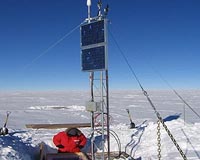 |
Bonn, Germany (SPX) Sep 15, 2009 We often speak of 'astronomically high prices' - 'astronomic' is a common way of describing anything that is extremely large. As a matter of fact, units of measurement are used in the field of astronomy that are far greater than the scale we are used to in everyday life. The nearest star - Proxima Centauri - is around 40,000,000,000,000 kilometres away. This example already shows that the unit of length that we are familiar with, the (kilo-) metre, is completely unsuitable for describing distances in the Universe - but what units are more suitable? Billions and trillions of kilometres are only a stone's throw in space, and these distances would bring us to only a small part of what is, for us, observable space. Therefore, in the field of astronomy special units of length are used, which are intended to make it easier to compare distances in space. Within our solar system, astronomers typically state distances as a multiple of the average radius of the Earth's orbit around the Sun. This 'Astronomical Unit' (AU) is 149,597,870,691 metres. It has become widely used, as several measuring methods provide their results directly in astronomical units and not in metres. The planet that is closest to the Sun, Mercury, is 0.39 astronomical units away from the Sun; Jupiter is 5.2 astronomical units away and Neptune is 30.1 astronomical units away. The distance to Proxima Centauri is about 270,000 astronomical units.
Dimensions used for space - astronomical unit, light year and parsec On the other hand, the unit usually used for distances between stars and galaxies is the 'parallax second', or parsec (pc) for short. It is based on the measured distance between stars that are close to the Sun. As a consequence of the Earth's annual orbit around the Sun, the position of a star of this type appears to change against the background of fixed, far away objects. This is called 'parallax' (see animation). Over the course of a year, the star appears to move in a tiny ellipse (or a circle) in the sky. The further the star is from the Earth, the smaller this circle appears. If the radius of the circle is so small that from Earth it appears to span only a tiny angle - one 3,600th of an angular degree (an 'arc second') - then the star is exactly one parsec away. One parsec corresponds to 3.26 light years. The star Proxima Centauri has the largest parallax, as it is closer to the Earth and also to the Sun than any other star. Its parallax is 0.772 arc seconds, which corresponds to a distance of around 1.3 parsecs. The distance between galaxies is normally many millions of parsecs and is therefore specified in megaparsecs (Mpc). Share This Article With Planet Earth
Related Links German Aerospace Center Space Tourism, Space Transport and Space Exploration News
 NSF Awards Space@VT Grant To Improve Space Weather Understanding
NSF Awards Space@VT Grant To Improve Space Weather UnderstandingBlacksburg VA (SPX) Aug 31, 2009 Members of Virginia Tech's Space@VT research group are receiving a $2 million grant from the National Science Foundation (NSF) to build a chain of space weather instrument stations in Antarctica. Space weather affects a variety of everyday consumer technologies including global positioning systems (GPS), satellites for television reception, and cellular phones. Also, the understanding of space ... read more |
|
| The content herein, unless otherwise known to be public domain, are Copyright 1995-2009 - SpaceDaily. AFP and UPI Wire Stories are copyright Agence France-Presse and United Press International. ESA Portal Reports are copyright European Space Agency. All NASA sourced material is public domain. Additional copyrights may apply in whole or part to other bona fide parties. Advertising does not imply endorsement,agreement or approval of any opinions, statements or information provided by SpaceDaily on any Web page published or hosted by SpaceDaily. Privacy Statement |